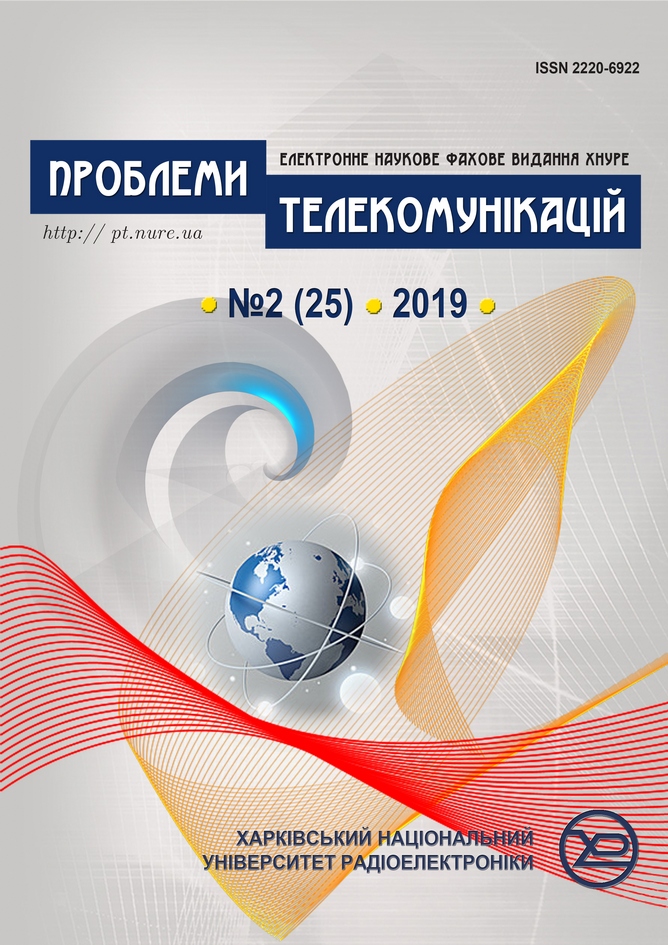Improvement of the flow-based multicast routing model on the principles of Traffic Engineering technology
DOI:
https://doi.org/10.30837/pt.2019.2.02Keywords:
Model, Routing, Balancing, Flow, Traffic, NetworkAbstract
The paper proposes to improve the mathematical model of multicast routing with balanced use of network resource in accordance with the requirements of the concept of Traffic Engineering (TE). The model is based on the optimality criterion, which quantitatively equals the minimization of the utilization rate of the most downloaded network link. A research of the proposed improved model on the number of network structures was conducted. The research found that when using the optimization criterion of minimization of the utilization rate of the most loaded network link, inappropriately loaded links occur. This is caused by the fact that utilization coefficients of these links are not the highest in the network, and they are not critical to the value of the optimality criterion, and therefore the flow of packets in those links was not prohibited. To solve this problem in the work it is proposed to introduce two additional conditions into the model, the fulfillment of the first condition implies that the flow can come from no more than one adjacent node to an arbitrary node; and the second condition is that the flow of packets on the incoming interfaces of the transit node can only appear if its outgoing interfaces are used. Using the proposed conditions, it was possible to solve the problem of misuse of the links resource without reducing the efficiency of the calculation solutions. The use of an advanced model allows balanced use of the network resource, especially for the traffic structure, which consists of a large number of multicast flows with relatively low intensity compared to the bandwidth of the links.References
Routing Protocols Companion Guide: 1st Edition, Kindle Edition. Cisco Networking Academy. Cisco Press. 2014. 792 p.
Szigeti T., Barton R., Hattingh Ch., Briley K. Jr. End-to-End QoS Network Design: Quality of Service for Rich-Media & Cloud Networks (Networking Technology) 2nd Edition. Cisco Press. 2013. 1040 p.
Loveless J. IP Multicast, Volume I: Cisco IP Multicast Networking (Networking Technology) 1st Edition. Cisco press. 2016. 384 p.
Rosenberg E. A Primer of Multicast Routing. Springer Briefs in Computer Science. 2012. 128 p.
Benjamin A., Chartrand G., Zhang P. The Fascinating World of Graph Theory. Princeton University Press. 2017. 344 p.
Bertsimas D. The Probabilistic Minimum Spanning Tree Problem: Part I--complexity and Combinatorial Properties. Palala Press. 2015. 50 p.
Forouzan B.A. TCP/IP Protocol Suite 4th Edition. McGraw-Hill Education. 2017.
Wang X., Hui C., and Min H. QoS multicast routing protocol oriented to cognitive network using competitive coevolutionary algorithm. Expert Systems with Applications. 2014. № 41(10). P. 4513-4528. DOI: https://doi.org/10.1016/j.eswa.2014.01.020
Marquez J., Gutierrez I., Sanchez E. Approach of Multicasting Routing with Solution for Network Coding Applying Edmonds-Karp. 2018 IEEE International Conference on Automation/XXIII Congress of the Chilean Association of Automatic Control (ICA-ACCA). 2018 DOI: https://doi.org/10.1109/ica-acca.2018.8609753
Kucharzak M., Walkowiak K. A mixed integer formulation for multicast flow assignment in multilayer networks. 2010 Fifth International Conference on Broadband and Biomedical Communications, 2010. P. 1-4. DOI: https://doi.org/10.1109/ib2com.2010.5723619
Kotachi S., Sato T., Shinkuma R., Oki E. Multicast Routing Model to Minimize Number of Flow Entries in Software-Defined Network. 2019 20th Asia-Pacific Network Operations and Management Symposium (APNOMS), 2019. P. 1-6. DOI: https://doi.org/10.23919/apnoms.2019.8893074
Лемешко А.В., Арус К.М. Потоковые модели многоадресной и широковещательной маршрутизации в телекоммуникационных сетях. Проблеми телекомунікацій. 2013. № 1 (10). С. 38-45. URL: http://pt.nure.ua/wp-content/uploads/2020/01/151_lemeshko_coordination.pdf
Lemeshko O., Arous K. The flow-based model of multicast routing. 23rd Interational Crimean Conference “Microwave & Telecommunication Technology”, Sevastopol, Crimea, Ukraine, 2013. P. 523-524.
Nevzorova O., Arous K., Hailan A. Flow-based model of hierarchical multicast routing. Second International Scientific-Practical Conference «Problems of Infocommunications Science and Technology» PICS&T’2015, Kharkiv, Ukraine, October 13-15, 2015. P. 50-53. DOI: https://doi.org/10.1109/INFOCOMMST.2015.7357266
Seok Y., Lee Y., Choi Y., Kim C. Dynamic Constrained Traffic Engineering for Multicast Routing. Proc. Wired Communications and Management. 2002. Vol. 2343. P. 278-288. DOI: https://doi.org/10.1007/3-540-45803-4_26
Wang Y., Wang Z. Explicit routing algorithms for Internet Traffic Engineering. Proc. of 8th International Conference on Computer Communications and Networks. Paris, 1999. P. 582-588. DOI: https://doi.org/10.1109/ICCCN.1999.805577
Downloads
Published
Issue
Section
License
Copyright (c) 2019 Olena Nevzorova, Batoul Sleiman, Amal Mersni, Vladyslav Sukhoteplyj

This work is licensed under a Creative Commons Attribution-NonCommercial-ShareAlike 4.0 International License.
Authors who publish with this journal agree to the following terms:- Authors retain copyright and grant the journal right of first publication with the work simultaneously licensed under a Creative Commons Attribution License that allows others to share the work with an acknowledgment of the work's authorship and initial publication in this journal.
- Authors are able to enter into separate, additional contractual arrangements for the non-exclusive distribution of the journal's published version of the work (e.g., post it to an institutional repository or publish it in a book), with an acknowledgment of its initial publication in this journal.
- Authors are permitted and encouraged to post their work online (e.g., in institutional repositories or on their website) prior to and during the submission process, as it can lead to productive exchanges, as well as earlier and greater citation of published work (See The Effect of Open Access).

